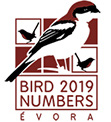Field Trips
Field Trip 1 – Cork oak forests (‘montados’) and Tagus Estuary
Cork oak forested areas called ‘montados’ are HNV Mediterranean ecosystems with a diverse bird fauna all year around.
In this field trip you will have the chance to explore sounds and sights of breeding bird communities in some of the most interesting Portuguese ‘montados’ bordering the Tagus estuary (a Ramsar site), the largest in Western Europe and the second most important wetland for waders in the Iberian Peninsula.
Bird hotspots: EVOA – geral, EVOA Lagoa principal, EVOA Lagoa rasa
Field Trip 1a
07:45 – Gathering in Rossio de São Brás
08:00 – Departure from Évora
09:30 – Arrival at Companhia das Lezírias – cork oaks | rice fields | pinewoods
11:20 – Departure to EVOA
12:00 – Lunch in EVOA
13:00 – Visit to EVOA wetlands
16:00 – Departure to Évora
18:30 – Arrival to restaurant for the Conference Dinner
With support from Benavente Municipality
Field Trip 1b
07:45 – Gathering in Rossio de São Brás
08:00 – Departure from Évora
10:15 – Arrival at EVOA – wetlands
13:00 – Lunch in EVOA
14:00 – Departure from EVOA
14:40 – Arrival and visit to Companhia das Lezírias – cork oaks | rice fields | pinewoods
16:30 – Departure to Évora
18:30 – Arrival to restaurant for the Conference Dinner
With support from Vila Franca de Xira Municipality
Field Trip 3 – Castro Verde pseudo-steppe habitats
Traditional extensive farming systems are “European cultural landscapes” that include some of the most threatened birds in Europe.
These pseudo-steppe habitats are facing serious threats for their future due to modifications in land use and agricultural intensification. In Portugal, the most important area of pseudo-steppe habitats is located in the Castro Verde region (southern Alentejo), where traditional farming stills occurs at a large scale. In this field trip you will have the chance to see several steppe birds and to understand the uniqueness of this farming system with its mosaic of habitats and the cultural heritage of this region.
07:45 – Gathering in Rossio de São Brás
08:00 – Departure from Évora
09:45 – Arrival to Vale Gonçalinho – Castro Verde pseudo-steppe habitats
12:45 – Departure from Vale Gonçalinho
13:15 – Lunch at the Secondary School of Castro Verde
14:30 – Visit to Museum of Rural Life
16:00 – Departure to Évora
18:30 – Arrival to restaurant for the Conference Dinner
Bird hotspots: Vale Gonçalinho, ZPE Castro Verde
With support from Castro Verde Municipality
Field Trip 4 - The landscape around Évora
The Évora district offers several attractive possibilities for birdwatching due to the mosaic of agro-silvo-pastoral systems with high levels of biodiversity. You will also visit the Alandroal area at Juromenha where you can see the Alqueva Reservoir, the largest artificial lake in Europe.
In this field trip you will visit the area in the outskirts of Évora and Alandroal and will have the chance to see the landscape mosaic, their birds and also some threats.
07:45 – Gathering in Rossio de São Brás
08:00 – Departure from Évora
09:00 – Arrival at Juromenha – Alqueva reservoir | cork oak forests
12:00 – Departure to Évora
13:15 – Lunch in Herdade da Mitra (University of Évora)
14:15 – Walk on cork and holm oak areas
16:00 – Departure
16:35 – Arrival at Monte do Gavião – small wetland surrounded by agricultural landscape
18:00 – Departure to Évora
18:30 – Arrival to restaurant for the Conference Dinner
Bird hotspots: Juromenha, Mitra – LabOr, Mitra – Pinhal, Monte Gavião
With support from Alandroal Municipality
Field Trip 5 – Tagus salt marshes
The Tagus estuary is the largest in Western Europe covering an area of ca. 300 km2 at low tide and is surrounded by industries and cities.
This mesotidal estuary has a vast inner bay with extensive intertidal areas including salt marshes and mudflats. In this field trip you will visit several strategic places of the estuary including saltpans, where you can feel its peculiar atmosphere and some of their birds.
07:45 – Gathering in Rossio de São Brás
08:00 – Departure from Évora
09:30 – Arrival at Salinas do Samouco – salt marshes and saltpans
11:30 – Departure to the forest area of Mata da Machada
12:00 – Lunch and walk in Mata da Machada
14:00 – Departure
14:20 – Visit to Sapal de Alhos Vedros
15:50 – Departure to Évora
18:30 – Arrival to restaurant for the Conference Dinner
Bird hotspots: Salinas do Samouco, Mata da Machada, Sapal Alhos Vedros
With support from Barreiro Municipality
Top Photo © Fer Goytre
